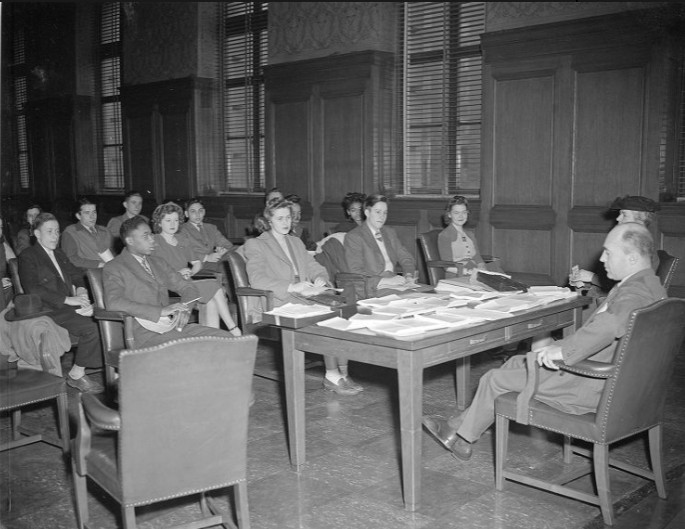Previously an uncoordinated citizens’ movement, Civil Defense (CD) became part of the Department of Defense during . The Indiana General Assembly passed the Indiana State Defense Act on March 10, 1941. The Act declared a period of emergency for defense purposes and created the Indiana Defense Council, which consisted of two bodies, the Advisor Defense Council and the Administrative Defense Council.

President Franklin D. Roosevelt created the Office of Civilian Defense by executive order in May 1941. A key mandate of the agency was the protection of the civilian population through the creation of volunteer services and functions. In Indiana, the volunteer services included Fire Watchers, Air Raid Wardens, Auxiliary Police, Decontamination Corps, the Rescue Party, Medical Corps, and the Demolition and Clearance Crew. The CD organized fire fighters at the in Indianapolis. This group watched for sabotage and participated in scrap metal and War Bond drives. A related organization allied with Civil Defense, called the Passive Defense Force, organized Indianapolis industries to protect workers and ensure production.
An executive order on June 4, 1945, terminated the Office of Civilian Defense (CD) as it related to wartime protection of the civilian population due to World War II.

During the 1950s, emergency management was dominated by wartime civil defense activities that the government believed would prepare the nation for a possible nuclear attack. In Indianapolis, hundreds of men attended firefighting classes at neighborhood engine houses. The CD placed air raid sirens downtown and assigned wardens to the largest buildings. Indiana State Fairgrounds buildings housed radio equipment for emergency communications via several local radio stations.
In the early 1960s, Indianapolis had one of the largest CD police training classes in the nation. Lessons ranged from combatting the supposed Communist menace to recognizing mentally ill persons. Directed from CD headquarters at 3951 North Illinois Street, 1,200 people in 1964 participated in Operation Alert, which simulated an enemy air attack. During the Cuban missile crisis (1962), CD encouraged the building of family fallout shelters in Indianapolis. Schools practiced “Duck and Cover” drills with students to prepare them for a possible nuclear attack, but interest waned by the late 1970s when many private and public shelters were emptied of their stores.
Deadly tornados and snowstorms in the 1960s and 1970s shifted emergency management from wartime civil defense activities to natural disaster relief. Thirty-second weekly testing on Marion County’s 171 tornado warning sirens each Friday at 11 AM became a familiar sound that ushered the coming weekend. In 1979 President Jimmy Carter signed an executive order to create the Federal Emergency Management Agency (FEMA). This organization absorbed all responsibility for civil defense.
By the 1990s, the shift in emphases from military to non-military disaster readiness resulted in a name change for the Indiana Defense Council to the Marion County Emergency Management Division. This agency coordinated the state’s response to communities that needed help responding to disasters or implementing plans and processes to mitigate natural disasters. The division served as a liaison to FEMA when distributing individual assistance and public assistance to damaged communities.
In the 21st century, the concept of federal emergency management shifted in the wake of the September 11, 2001, terrorist attacks in New York City and Washington D.C. The U.S. Congress passed the Homeland Security Act of 2002, which created the Department of Homeland Security. This newly created agency absorbed FEMA in 2003.
In Indianapolis, the IMPD Homeland Security Bureau coordinates efforts among the different state agencies that deal with law enforcement, disaster preparedness and recovery, civilian protection, and civil defense. As of 2020, a full-time staff of four plans for all types of disasters. Warning sirens still sound for testing at 11 A.M. on Fridays, and “bell and light” warning systems sound in many businesses and hospitals. Funding comes from state and federal governments.

Help improve this entry
Contribute information, offer corrections, suggest images.
You can also recommend new entries related to this topic.